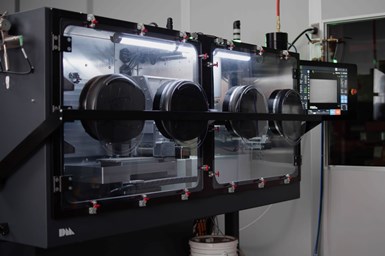Desktop Metal P-1 3D Printing System for End-Use Metal Parts
Rapid + TCT 2022: The P-1 shares the same Single Pass Jetting technology as the P-50, as well as common software and electronics for easy scalability.

Desktop Metal Production System P-1. Photo Credit: Desktop Metal
Desktop Metal’s Production System P-1 is a high-speed 3D printing system for end-use metal parts. It was designed as a gateway to the company’s top-of-the-line Production System P-50, which is the world’s fastest system to 3D print metal parts at scale, the company says.
The P-1 shares the same Single Pass Jetting (SPJ) technology as the P-50, as well as common software and electronics for easy scalability. This means full P-1 builds can be printed in less than one hour and process parameters can transfer directly to the P-50 for mass production jobs.
The company says the P-1 is now being used for a variety of development and serial production applications by a number of customers worldwide, including Ford Motor Co., Indo-MIM, Formula 3D Corp., Hong Kong Polytechnic University (PolyU), and Cetim - the Technical Center for Mechanical Industry in France.
The Production System is one of several Desktop Metal printing platforms that relies on binder jetting technology, which the company says is widely regarded as one of the 3D printing methods likely to deliver mass production additive manufacturing (AM) at high speeds and competitive prices.
Nearly a dozen metals are now qualified for printing on both systems which the company says deliver excellent part quality and surface finish, with sintered part mechanical properties that meet or exceed applicable industry standards, and final part densities up to or exceeding 99%. To date, the list of qualified materials includes stainless steels, including 17-4 PH, 316L, 420, 440C and DM HH SS; tool steels, including D2 and S7; low-alloy steels, including 4140; copper alloys; nickel superalloys, including IN625; and precious metals, including silver and gold. The company says Ti64 and 6061 is currently in development.
According to the company, this technology can help limit supply chain disruptions due to its ability to produce high-quality, cost-competitive end parts and tooling on demand for companies of all sizes, while delivering sustainability and innovation benefits.
Related Content
-
Lightweight Components: A Paradox When Machining
Today’s computer software can just as easily generate lightweight shapes for subtractive processes as it can for additive ones, but it increases cost and waste to make them.
-
To Scale Additive Manufacturing, Separate Design and Production
Spokbee’s online marketplace is designed to ease the launch and sale of customizable, 3D printed products. Its flexibility comes from cloud-based CAD and a distributed network of service bureaus for production.
-
3D Printed "Evolved Structures" for NASA Exoplanet Balloon Mission: The Cool Parts Show #61
Generative design creates stiff, lightweight brackets for EXCITE mission monitoring planets orbiting other stars. The Cool Parts Show visits Goddard Space Flight Center.










.png;maxWidth=300;quality=90)




